

Paraphrasing Worksheets
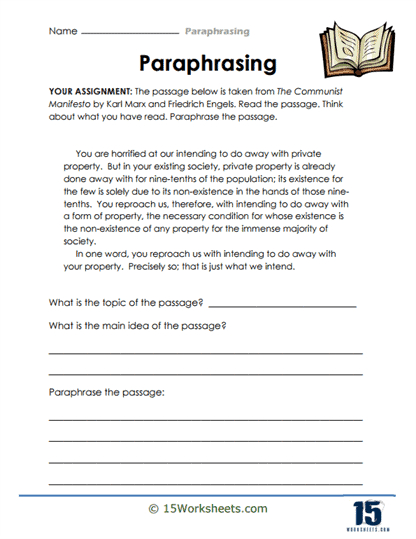
The Communist Manifesto
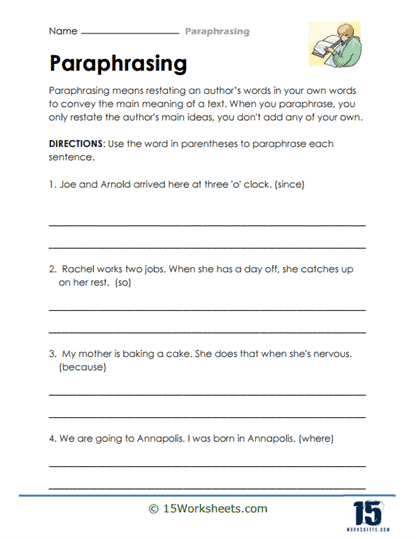
Restate The Passage
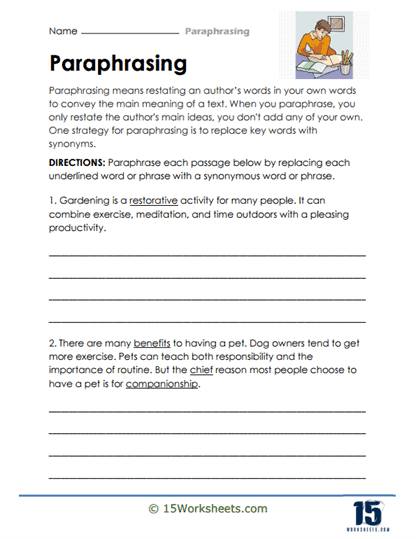
Synonymous Words
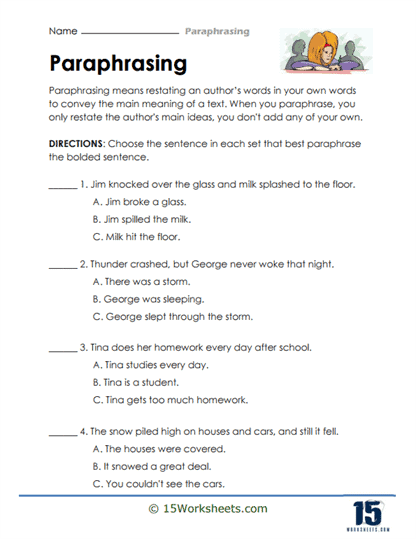
Make It Brief
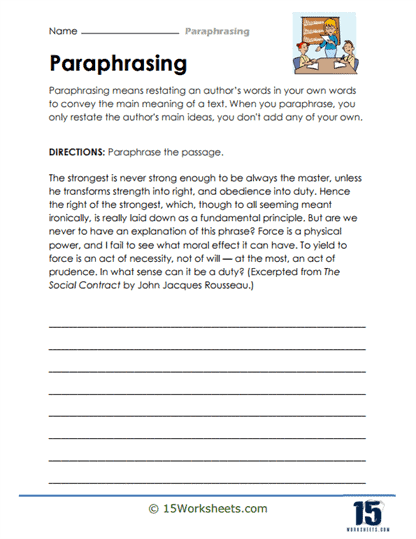
Just The Main Idea
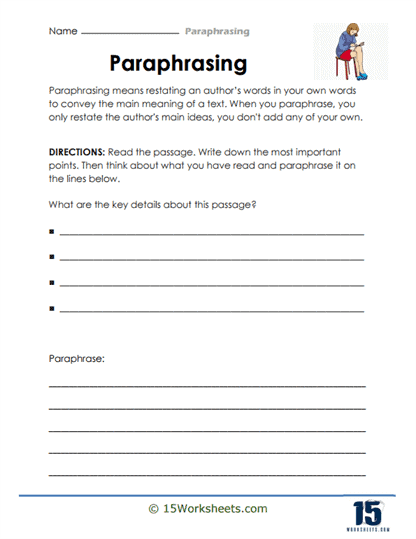
Key Details
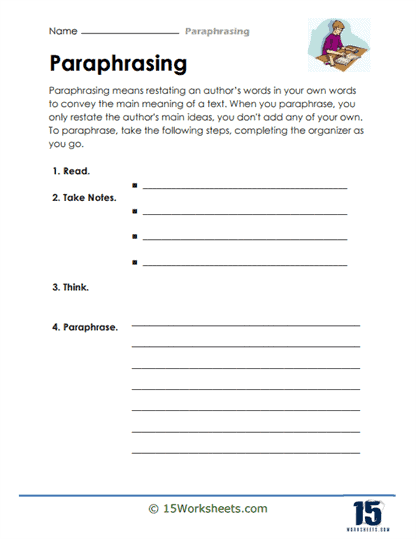
Take Notes And Think
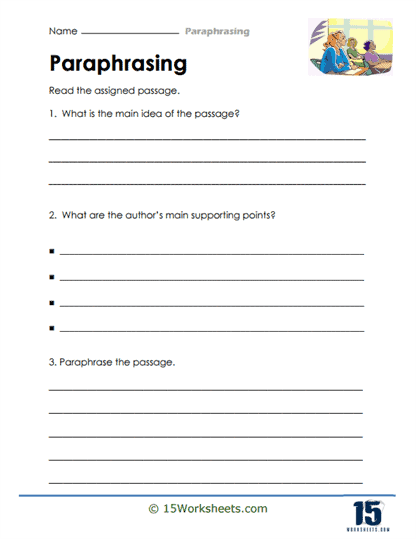

Listing Supporting Points
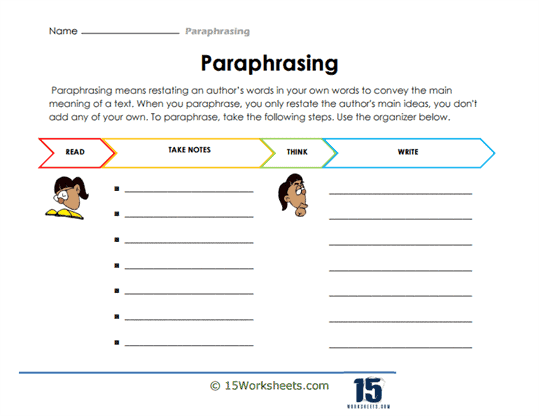
Learn The Process
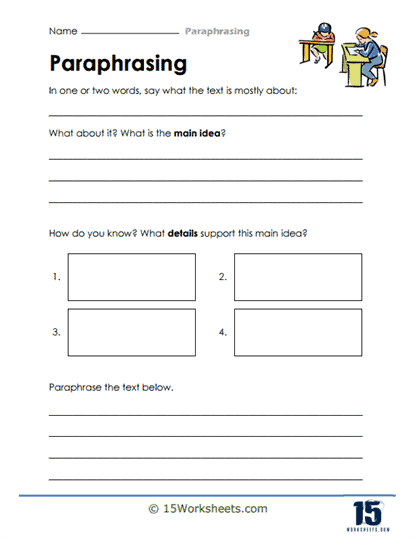
Articulate The Structure
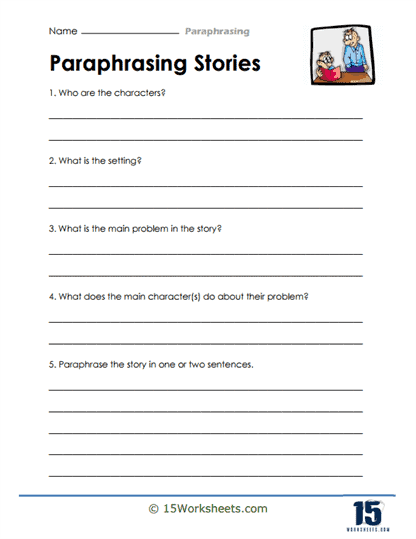
Paraphrase The Story
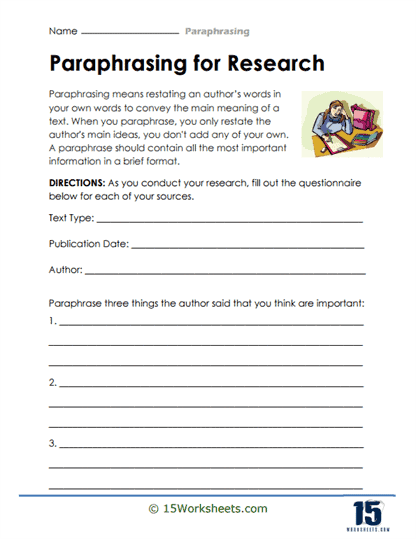
Conduct A Research
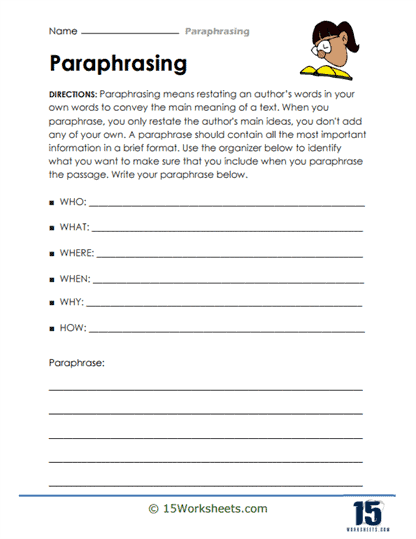
5 Wh And 1 H

Consulting Sources
All about these 15 worksheets.
Our paraphrasing worksheets will help students practice the skill of rephrasing sentences, paragraphs, or larger pieces of text in their own words. These worksheets typically provide a sentence or passage, followed by a space where the user is encouraged to rewrite the given text without changing its meaning. The goal of these exercises is to improve one’s ability to understand and convey information in a way that demonstrates comprehension while avoiding direct copying. By breaking down the structure and meaning of the original text, students develop a stronger grasp of language patterns, vocabulary, and syntax.
One of the primary benefits of using paraphrasing worksheets is that they enhance reading comprehension. When students rephrase sentences, they must first fully understand the meaning of the text before expressing it in their own words. This process forces them to think critically about word choice, sentence structure, and context, which in turn leads to a deeper understanding of the material. By regularly practicing this skill, learners become more adept at breaking down complex texts, making it easier for them to analyze and interpret various forms of writing, whether it be fiction, non-fiction, or academic material.
Paraphrasing worksheets also encourage the development of a more versatile vocabulary. When rewording a sentence or passage, students are challenged to use synonyms and alternative phrasing without altering the intended meaning. This stretches their vocabulary and exposes them to new words and expressions, making them more confident in their language use. Additionally, it helps them become more aware of subtle differences in meaning between words, fostering precision in their writing and communication.
For those looking to improve their writing skills, paraphrasing exercises are invaluable. They help learners practice creating original text that avoids plagiarism while still accurately conveying information. This is a crucial skill for academic and professional writing, where originality and clarity are paramount. By working on these worksheets, students gain confidence in producing their own work and learn how to structure their sentences and ideas in a clearer and more coherent manner.
This collection of worksheets can be particularly helpful for English language learners (ELLs) or individuals looking to enhance their fluency in a second language. Since these worksheets focus on rewording rather than directly translating, learners are encouraged to think in the target language, building stronger linguistic connections. This not only improves their language comprehension but also helps them develop a natural feel for idiomatic expressions and the nuances of grammar in the new language.
Paraphrasing involves rephrasing the words of others to convey the same meaning in a new and original way. It’s an important skill to develop for writing essays, research papers, and for understanding complex texts. We work on a wide variety of skills including:
Passages to Paraphrase – These include short passages that students are asked to paraphrase. This helps students practice putting ideas into their own words.
Comparing Paraphrases – Students might be given an original passage and several paraphrased versions, and asked to identify the best paraphrase. This can help students understand what makes a good paraphrase.
Paraphrase and Original Side by Side – These include an original text and a paraphrase side by side, asking students to identify the similarities and differences. This can help students understand how to maintain the original meaning while changing the wording.
Originality Awareness – The focus here is on distinguishing between paraphrasing and plagiarism, teaching students the importance of changing the structure and words of the original text significantly, and of giving credit to the original source.
What Are the 3 Ways of Paraphrasing?
Here are three common techniques for paraphrasing:
1. Change the Word Order
Changing the sentence structure can be an effective way to paraphrase. Be careful to ensure that the new sentence still accurately represents the original meaning.
2. Use Synonyms
Replace words with their synonyms, but be careful about the words that have no exact synonym or whose meanings vary based on context. Always double-check to make sure that the synonyms fit the context and preserve the original meaning.
3. Change the Voice
If the sentence is in active voice, you can change it to passive voice, and vice versa. However, you should use this method judiciously as overuse of the passive voice can make your writing seem weak or awkward.
Let’s take an example sentence to illustrate these techniques:
Original sentence: “The cat chased the mouse.”
Change the Word Order: “The mouse was chased by the cat.”
Use Synonyms: “The feline pursued the rodent.”
Change the Voice: “The mouse was being chased by the cat.”
Remember, even when you paraphrase, you must provide appropriate citation. Paraphrasing is not just about changing words but about fully understanding and conveying the original idea in your own style. Even if you’ve put the idea into your own words, it’s still someone else’s idea, so it’s important to give credit where it’s due.
What Are the 5 Steps of Paraphrasing?
Step 1: Read and Understand the Original Text
First, thoroughly read the original text to ensure you fully understand the meaning. You might need to read difficult or complex texts several times before you grasp the core idea.
Step 2: Identify the Main Ideas
Once you understand the text, identify the main ideas that you want to include in your paraphrase. This step might involve taking notes or highlighting key points in the text.
Step 3: Write Without Looking at the Original
Put the original text aside and write the paraphrase in your own words. This helps to ensure that you’re not just substituting words with synonyms but truly expressing the idea in a new way.
Step 4: Compare With the Original
After writing, compare your paraphrase with the original text. Make sure you have accurately represented the main ideas and details, and that your paraphrase is significantly different from the original. Check that you haven’t inadvertently used the same phrases or sentence structures.
Step 5: Cite the Source
Even though you are paraphrasing, the ideas are still someone else’s, so it’s important to appropriately cite the source of the information. The citation style (e.g., APA, MLA, Chicago) you use will depend on the academic discipline or the preference of your instructor or institution.

IMAGES
VIDEO